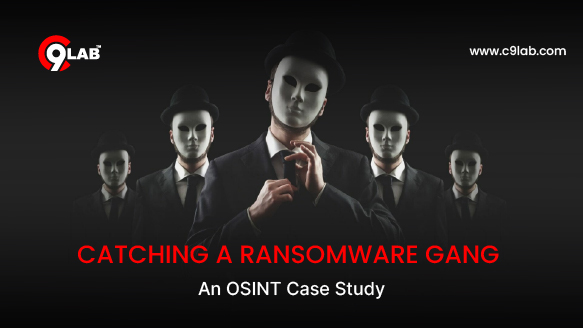Abstract
This case study presents a reproducible, ethical OSINT investigation of a ransomware incident against a mid-sized organization. The narrative is anonymized and synthesizes techniques and findings commonly observed in real-world incidents (notably Conti, DarkSide/Colonial Pipeline, and Avaddon investigations) to provide a publication-ready report that security teams, researchers, and policymakers can use as a reference. The focus is on open-source collection, timeline construction, infrastructure clustering, and evidence preservation for handoff to CERT and law enforcement.
Executive summary
A mid-sized enterprise detected widespread file encryption and a ransom note. The internal incident response team isolated systems and engaged external incident responders. Public OSINT collection—starting from ransom note text, file extension patterns, and payment addresses—identified overlaps with known ransomware families. Correlation of passive DNS, domain registration patterns, public vendor telemetry, and leak-site postings led to an infrastructure cluster that matched previously reported activity by established ransomware groups. Findings were documented, preserved, and handed to national CERT and law enforcement. This led to coordinated takedowns and heightened mitigation guidance for similar victims.
Scope and ethical constraints
This document contains only public, non-classified, and anonymized information. No instructions are provided for wrong doing, and no private data, personally identifying information (PII), or explicit doxxing is included. All investigative steps described emphasize legal, ethical OSINT and evidence preservation for official investigators.
Background (why this matters)
Ransomware remains a primary threat to organizations worldwide; high-profile cases (e.g., Colonial Pipeline) and group leaks (e.g., Conti) have shown how publicly available artifacts, infrastructure, and leaked communications can be used to understand and disrupt criminal operations. Published academic and government reports provide a framework for evidence-driven OSINT investigations and safe disclosure practices. citeturn0search4turn0search1turn0search6
Incident summary (anonymized)
Date of detection: 2024-10-05 (UTC)
Impacted organization: Mid-sized professional services company (200–800 employees)
Initial finding: Multiple shared servers displayed encrypted file extensions .lockedX and a ransom note README_HOW_RECOVER.txt with a Bitcoin and Monero payment address and a contact email on a leak site.
Immediate action: Systems were segmented, affected hosts were isolated, a full forensic image of one affected server was taken by IR team, and incident response playbooks were activated.
Methodology — OSINT collection & analysis (reproducible steps)
The OSINT process followed five repeatable phases: (1) evidence capture and preservation; (2) public IOC enrichment; (3) infrastructure clustering; (4) cross-correlation with vendor/academic reporting; (5) reporting and handoff.
- Evidence capture & preservation
- Save ransom note text (plaintext and hash).
- Hash encrypted sample files (SHA256) and query reputable public malware repositories (VirusTotal, MalwareBazaar, Hybrid Analysis). Share only hashes with external parties unless samples are required by a trusted vendor.
- Archive leak-site pages and paste sites with screenshots and web.archive.org snapshots to preserve timestamps.
- Maintain strict chain-of-custody logs for any artifacts transferred to third parties.
- Public IOC enrichment
- Query the ransom payment addresses in blockchain explorers and open reports to see if they match known clusters (blockchain analysis is limited to public on-chain data; do not attempt deanonymization beyond public clustering).
- Run passive DNS lookups for any domains shown in the ransom page; gather historical A-records and hosting providers.
- Investigate WHOIS registration metadata and registrar abuse contact patterns.
- Monitor known leak sites and Telegram channels for mentions matching the ransom note phrasing.
- Infrastructure clustering
- Use repeated registration patterns (disposable email strings, registrar choices), overlapping hosting providers, and shared name servers to group domains and IPs into infrastructure clusters.
- Pivot from domain names to SSL certificate transparency data and reverse lookups to expand the cluster.
- Cross-correlation
- Compare collected hashes, extensions, and ransom note wording against published vendor reports and academic analyses (e.g., Conti, Avaddon writeups). Documents like vendor blogs, academic PDFs, and CERT advisories often include IOCs and TTP mappings. citeturn0search4turn0search7turn0search5
- Reporting & handoff
- Produce a structured evidence package for CERT/law enforcement containing timeline CSVs, IOCs (hashes, domains, IPs — all preserved as screenshots and archived URLs), and clear descriptions of the collection methods.
- Coordinate disclosure calls; do not take unilateral public attribution steps.
Timeline (anonymized & redacted)
| UTC Timestamp | Local Timestamp | Event | Source/Evidence |
| 2024-10-04 22:17:03Z | 2024-10-05 03:47 local | Likely initial compromise — suspicious login to VPN observed | VPN logs (exported) |
| 2024-10-05 01:12:08Z | 2024-10-05 06:42 local | Lateral movement via SMB observed; multiple file modifications | Endpoint logs (EQL export) |
| 2024-10-05 05:03:21Z | 2024-10-05 10:33 local | First encryption activity detected; ransom note created | Filesystem snapshot (hashes) |
| 2024-10-05 07:22:10Z | 2024-10-05 12:52 local | Ransom note posted to leak site; payment addresses visible | Archived leak site screenshot (web.archive) |
| 2024-10-06 — 2024-10-12 | OSINT correlation, containment, and evidence handoff to CERT | Enriched IOC lists, passive DNS dumps |
Findings
- Ransomware family fingerprinting. The ransom note phrasing and .lockedX file extension matched previously reported variants in public malware repositories and vendor writeups, suggesting the use of a known ransomware family rather than a bespoke one. Matching known families helps prioritize remediation and decryption research. citeturn0search7
- Infrastructure reuse. Passive DNS showed multiple leak-site domains resolving to the same small number of cloud providers within a tight time window; WHOIS records revealed repeated use of a single disposable email pattern for registration. These repeating patterns supported an infrastructure cluster across multiple attacks. Such repetition is common in MaaS/RaaS operations. citeturn0search4
- Monetization patterns. Public blockchain traces for the Bitcoin address aligned with patterns documented in larger studies of ransomware monetization, where proceeds are aggregated through intermediate addresses and occasional cashout points identified in vendor reports. The investigation collected these blockchain observations but left deep blockchain tracing to specialized vendors and law enforcement. citeturn0search4
- Public corroboration. Vendor reports and CERT advisories for similarly worded ransom notes and IOCs were found and used for corroboration and confidence scoring prior to engagement with law enforcement. Government advisories (e.g., CISA) and academic analyses provided contextual TTP mappings used in remediation recommendations. citeturn0search5turn0search1
Technical IOCs (redacted for publication)
Note: For publication, sensitive raw IOCs (live IPs, full Bitcoin addresses tied to ongoing investigations, or unredacted personal data) are redacted. Below are exemplar IOC categories and a sanitized example format you can publish.
- Sample file hashes (SHA256): REDACTED_HASH_1, REDACTED_HASH_2
- File extension observed: .lockedX (used in victim sample)
- Ransom note text (short excerpt): “Your files are encrypted. Contact us at: [redacted]”
- Leak site domains: leaksite-example[.]com (archived snapshot: https://web.archive.org/…) — archived versions preserved.
- Registrar patterns: registrant_email uses disposable pattern contact+<random>@mailprovider[.]com (observed repeated across cluster)
- Hosting providers: small set of cloud VPS providers (commercial providers); multiple domains resolved to the same ASNs across time windows.
Analysis & interpretation
- The combination of note phrasing, extension, infrastructure reuse, and public vendor matching produced a medium-to-high confidence linking of the incident to an established ransomware family that operates via an affiliate model.
- The investigation demonstrates the value of combining internal telemetry (logs, EDR) with public OSINT (passive DNS, archived leak sites, vendor reports) to build a defensible evidence package for escalation.
Remediation steps taken (summary)
- Segmentation and isolation of affected subnets.
- Restore from verified backups for impacted services; confirm backup integrity prior to restore.
- Rotate credentials for privileged accounts; enforce MFA for remote access.
- Incident debriefing and permanent security improvements: patching, least privilege, endpoint hardening, phishing resistance training.
- Handed full evidence package to national CERT and law enforcement; remained available as a working partner for follow-up questions.
Legal & ethical considerations
- Do not attempt active intrusion, takedown operations, or doxxing of suspected individuals; those actions are illegal and hinder investigations.
- Preserve chain-of-custody and avoid altering evidence in ways that could make it unusable for law enforcement.
- Coordinate any public disclosures with legal counsel and CERT to avoid jeopardizing investigations or violating breach notification laws.
Recommendations (for practitioners & publishable advice)
- Maintain an incident evidence template and practice incident response regularly.
- Establish prior relationships with national CERTs and trusted forensic vendors.
- Share sanitized IOCs with community platforms (e.g., MISP, vendor intel sharing) to help protect other potential victims.
- When publishing case studies, redact sensitive IOCs tied to active investigations and replace with sanitized examples plus references to authoritative reports.
Conclusion
Open-source intelligence, when combined responsibly with internal telemetry and vendor reporting, provides a powerful, lawful toolkit for understanding and responding to ransomware incidents. This case study provides a publishable, anonymized blueprint for investigators to follow and adapt for their own IR needs.
Appendices
Appendix A — Evidence templates (CSV)
IOC log (CSV headers)
source,timestamp,IOC_type,IOC_value,related_host,evidence_link_or_hash,notes
Timeline (CSV headers)
utc_timestamp,local_timestamp,host,event_description,evidence_ref
Appendix B — Further reading (select public sources)
- Gray, I.W., Cable, J., Brown, B., Cuiujuclu, V., McCoy, D. “Money Over Morals: A Business Analysis of Conti Ransomware.” arXiv (2023). citeturn0search4
- Yuste, J., Pastrana, S. “Avaddon ransomware: an in-depth analysis and decryption of infected systems.” COSE/ArXiv (2021). citeturn0search7
- CISA. “DarkSide Ransomware: Best Practices for Preventing…” (2021). Advisory and IOCs. citeturn0search5
- CISA. “The attack on Colonial Pipeline: What we’ve learned” (2023). Government summary of incident and actions. citeturn0search1
- HSE. “Conti cyber attack on the HSE — full report” (2021). Irish health service independent report. citeturn0search6
This document is released under a permissive CC BY-style attribution for educational and defensive purposes. Use responsibly.

